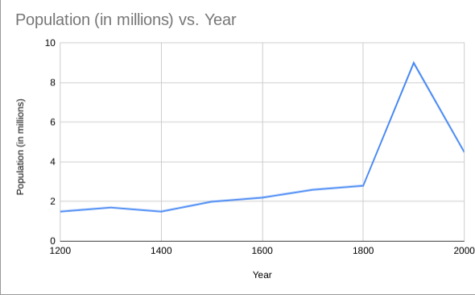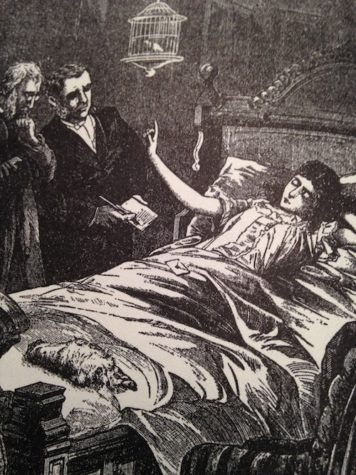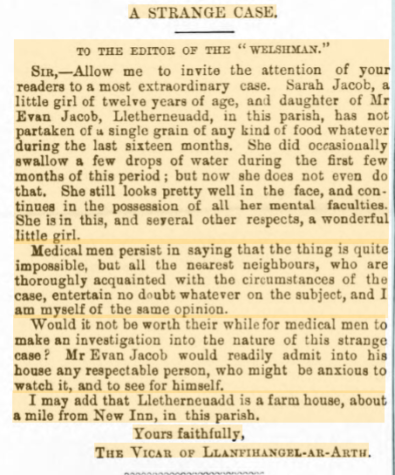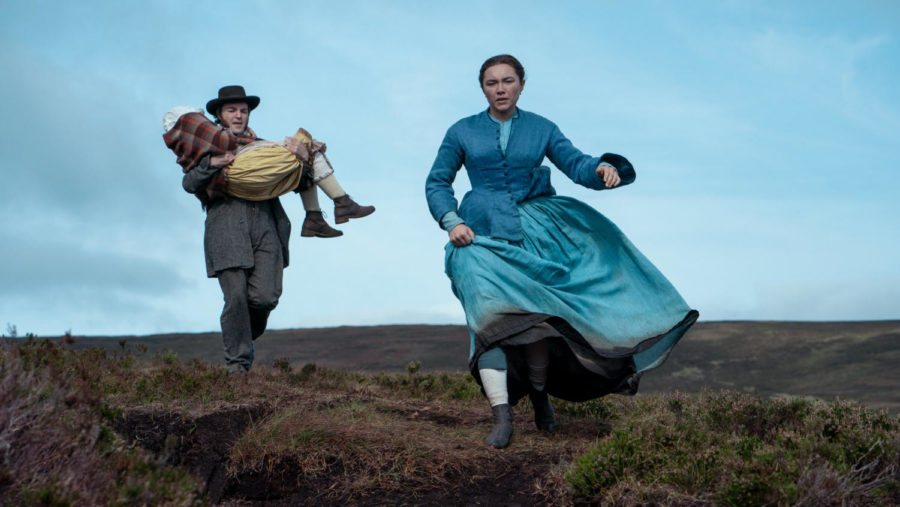Dive into Donoghue’s story “The Wonder” and the history of the original fasting girls.
“The Wonder,” written by Emma Donoghue, makes its viewers care about something viewed for generations as selfish, toxic, and almost cowardly behavior: self-harm. The story’s protagonist Elizabeth “Lib” Wright, played by Florence Pugh, is called to northern Ireland for a “watch,” more specifically, to watch a girl for fourteen days who claims to survive solely on “Manna from Heaven.” In the Bible, God gives Manna to the Israelites leaving Egypt as their food ran out. Sustenance of the holiest form.
She tells the inquiring local church that she hasn’t eaten real food since her eleventh birthday… four months prior. She should be dead, instead, they declare her a miracle, a saint. To confirm this oddity, Lib is called in from her nursing post in England to watch the girl in eight-hour shifts along with the help of a nun in determining if the girl is truly a miracle.
“The Wonder” is set in 1862, a decade after the Great Irish Famine. The aftermath of this horror story still plagues the country. The famine raged across Ireland in the late 1840s, caused by a potato blight that took out the country’s staple food. Millions died of starvation.

Lib’s romantic interest, Tom Burke’s (William Byrne) family wasted away from starvation, and he retells his family’s tragic story to Lib, explaining how they locked themselves inside their house in their final days, in an effort to die with dignity. During the famine, it was not uncommon for corpses to litter the common areas, dropping dead from exhaustion due to extreme starvation.
Still, Anna O’Donnel (Kila Lord Kassidy), the miracle girl, fasts herself willingly, even denying precious food from her parents. Anna is portrayed as an odd and somewhat isolated girl with few words, but when she speaks her words are simple, but astute, always demanding an answer. The first clue to her reasoning for her fast is presented in a sweet scene when Lib inquires about her cards. Each card depicts a saint. She is specifically infatuated with Mary, the purest and beloved of saints. After witnessing her fascination with saints, Lib learns that the behavior isn’t due to neglectful or abusive parents, it’s a fast.
Fasting is a spiritual discipline taught in the Bible as a sacrifice for God, in which one will forgo food and sustenance for a period of time without complaints, learning to suffer quietly, as it is said that God will reward this. Fasting is still a common religious and cultural tradition today as well as a common diet fad to lose weight quickly. Both can be effective and successful if done with caution, or can be unhealthy and self-destructive if abused; Anna’s fast being the latter. In the movie, her motives for why she so desperately wants to purify herself through fasting are revealed.

Anna’s self-inflicted starvation creates a stark contrast with Ireland’s recent mass starvation where people see eating as a luxury that could be robbed from them at any moment. Her behavior is viewed as unreasonable, yet once her reasoning is explained watchers pity her, seeing that she is a victim of her own extreme religious beliefs.
“The Wonder” is realistic fiction, with Donahuge’s characters being based on real people. Sarah Jacob and Mollie Fancher, the Welsh Fasting Girl and the Brooklyn Enigma, are both known as the most famous “fasting girls” to ever exist.
When Molly J. Fancher was nineteen years old, reports were made that she had abstained from eating for seven weeks straight. People weren’t sure if it was for a diet or if it was really a “supernatural” miracle. In 1865 she suffered in a tragic accident upon exiting a trolley, getting stuck and being dragged across the pavement for over a block. She sustained severe spinal injuries and was confined to her bed for the rest of her life due to limb paralysis. Though proceeded to lose her sight and her hearing, she claimed she could see with her hands behind her back with her “third eye.”

During the Victorian era, there was a push for the secularization, of church and politics. This left a space for increased interest in the supernatural, contributing to the public’s obsession with the Fancher story. The majority of tourists had a huge interest in her claimed “supernatural” powers, even PT Barnum was rumored to have offered her a “golden bed of dove feathers” to join his circus, yet her fasting is what really caught the attention of doctors William Hammond and George Beard. Both wrote her off as fraudulent, unbelieving in her prolonged fast. Hammond even added that it was the public’s willingness to feed into her theatrics that allowed her to get away with blatant fraud. Fancher died in 1916, without any explanation of how she may have pulled off a medical miracle.
The second fasting girl that inspired “The Wonder” of Anna O’Donnel was Sarah Jacob, the Welsh fasting girl. Her parents published her tale publicly to draw attention and visitors to their home. They flaunted their miracle daughter in the local paper the “Welshman,” in the February 19, 1869 issue, explaining how she had not eaten in sixteen weeks, living, on no sustenance besides a few drops of water.
The public interest demanded answers, many believing she was deceitful and secretly eating at night. They called it a watch. Four nurses from Guy’s Hospital in London were called to watch the girl for fourteen days. Within a week she had an “altered appearance,” and showed obvious signs of starvation. Jacob died on December 17, 1869.

Emma Donoghue based her character Anna O’Donnel heavily on Sarah Jacob, yet gave her a second chance at life, and an opportunity to be reborn. Anna wanted to die, but she had made her peace with it, while Lib’s priority was her health. In refusing to let the girl die, she suggested that Anna be reborn as Nan, a new little girl with no trauma. Nan lived with Lib and Thomas in Australia. The last scene is her eating, willingly, at a communal table with her new supportive family, it’s the beginning of her new happy and healthy life.
Despite not being the main focus of the story, anorexia plays a huge part in the character’s journey. Due to lack of food Anna’s body severely struggles with starvation, to the verge of death. If you are struggling with eating disorders, this movie might be triggering and difficult to watch, so enjoy it with caution.
Helpline for Eating Disorders:
https://www.nationaleatingdisorders.org/help-support/contact-helpline
Pema Secrest is an incredibly average human being and wannabe writer. She is a sophomore at Arroyo Grande Highschool and is ready to leave. ...
















